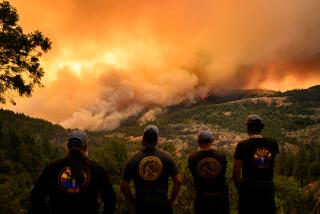Sequoia Blaze Keeps on Burning
- Share via
KERNVILLE, Calif. — In the midst of a disastrous fire season across the West, the campfire remains a tradition unchanged in much of the Sequoia National Forest, where a 57,000-acre fire continued to burn late Thursday.
Campers in many parts of this forest can still cook their meals over wood or kerosene flames beneath pines and cottonwoods.
It was a campsite at a place called Road’s End where Peri VanBrunt set up last Sunday. She would later tell people that she had been preparing to cook hot dogs in a designated “safe fire” area when the blaze broke out.
As of Thursday, the slow-moving fire had not entered any of the groves of giant sequoia trees for which the forest is named. About 1,500 additional acres had burned, far fewer than in previous days. But the blaze had landed the 45-year-old Bakersfield mother in jail and raised questions whether the U.S. Forest Service had tempted fate by allowing campfires in this of all fire seasons.
The Sequoia National Forest supervisor, Art Gaffrey, acknowledged Thursday that the forest was so dry it seemed like August, not July.
And yet the Forest Service had not changed its long-standing practice. It would allow campers in the busy months of summer to build fires and cook over stoves in some locations, including the area where the fire started, a stretch of rock, sand and a little brush near a road and a river.
The agency deemed other sections of the forest off-limits to such activity because of the fire danger.
Gaffrey said Thursday that the Forest Service would take a second look at those areas where campfires are still permitted.
Gaffrey likened the situation to a freeway: If everyone followed the rules, there would be no accidents. “I’ve been here for 6 1/2 years, and I’ve never closed the dispersed areas to campfires,” he said. “They’ve always provided a safe area as long as the regulations are followed.”
Gaffrey said he didn’t know what had happened in the moments before the fire started. But, like other officials, he described VanBrunt as the culprit.
“I’m not sure if she had the fire circle cleaned,” he said. “Did she have a shovel? Was she tending the fire?”
VanBrunt is scheduled to be arraigned this morning in U.S. District Court on felony charges of setting the fire. If guilty, she could face five years in prison.
Special agents with the U.S. Forest Service have said VanBrunt has admitted starting the fire, but has insisted that it wasn’t intentional and that the fire escaped her control. The agents said she had not obtained a fire permit before entering the forest. VanBrunt has no criminal history related to fires. In 1998, a judge sentenced her to 16 months in state prison after she pleaded guilty to a methamphetamine charge.
She and her husband, Gary, and two children live in a large, rundown old house in Bakersfield. A U.S. flag and an Oakland Raiders banner hang from the front porch. Six abandoned automobiles litter the yard. A sign in the window says: “Private Property, Stay Off.”
“Peri has told people that she did everything she could to put out the fire, but nobody would help her,” said a neighbor, Raquel Gonzales. “Peri is a good neighbor.”
Meanwhile, the fire continued to blacken the slopes of the Kern River Valley, although it had so far spared groves of some of the nation’s largest and oldest trees--including the General Sherman in Sequoia National Park, miles to the north, which stands 274 feet tall.
The wildfire, Gaffrey said, was slowing down, and crews were holding the line on the western side of the blaze, which borders a giant sequoia grove. “The conditions have looked the best I’ve seen them.”
By nightfall, the blaze was about 10% contained, a forest service official said, adding that it could be a week or more before the fire is completely contained.
Battered by weeks of 100-degree-plus heat, people in Bakersfield and Fresno typically flee in two directions every summer. They head west to the Central Coast or east to the national forests.
They look for a few days’ break from the smog and the dust of the harvest, a chance to cook over a campfire and to sleep next to the ocean or beneath the giant sequoias.
The U.S. Forest Service is loath to deny them their summer respite. And yet, when communing with nature produces fire, as it did this week, critics of the Forest Service wonder whether the policy needs to be altered.
They say the Forest Service dragged its heels in managing the sequoia groves, failing to reintroduce prescribed burns as a way to reduce the dead wood and underbrush that have fueled this fire. Logged areas, they say, have been too heavily replanted with young, small trees that burn hotter.
“This is a very dry and arid forest, and the logging program has increased the brush and flammability of the forest,” said Charlene Little, a Kernville resident who sits on the board of Forestkeepers, a conservation group.
Campfires are permitted along the entire 18-mile strip where VanBrunt was camping legally.
Gaffrey said he had driven by the spot where the fire began and had seen a singed trailer, but he wasn’t sure if it belonged to VanBrunt.
The fire “hit grass” and exploded, he said. “This is not a usual occurrence.” The Forest Service banned campfires earlier this summer north of Lake Isabella because of the fire danger, but it left open the Kern River Valley.
*
Times staff writers William Overend, Steve Hymon and Eric Malnic contributed to this report.
More to Read
Sign up for Essential California
The most important California stories and recommendations in your inbox every morning.
You may occasionally receive promotional content from the Los Angeles Times.














